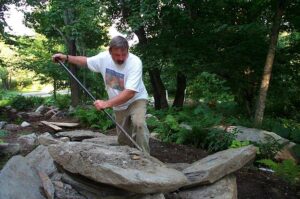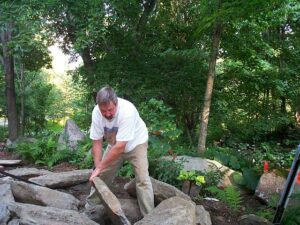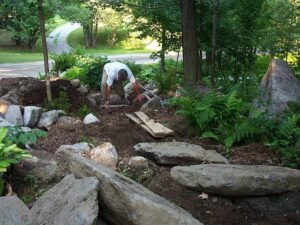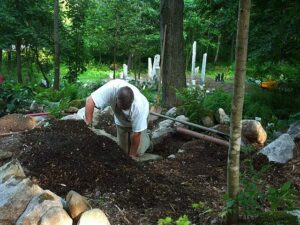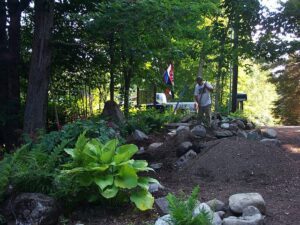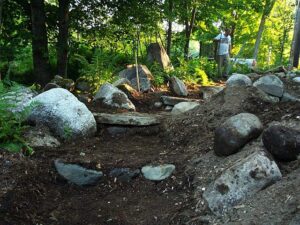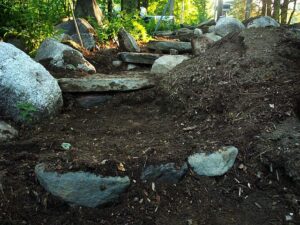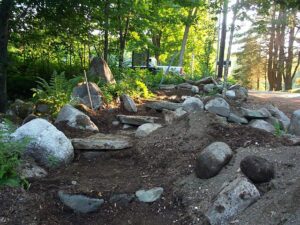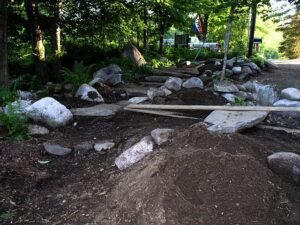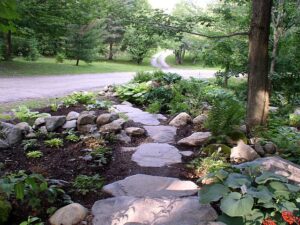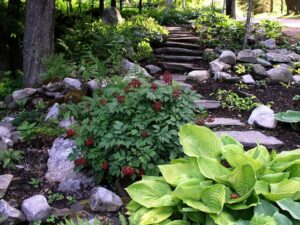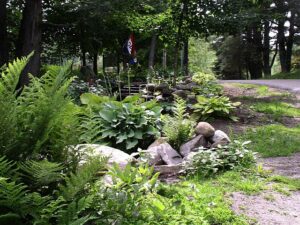Building Stone Steps
Gail and I appreciate the use of stone in gardens. Maybe it’s because our first garden together on the shores of Lake Champlain included glacial till that was absolutely free of stones. The man we rented the property from even told us that the absence of stones would become very apparent the first time we needed a “hoe knocker”. He was right.
I wrote the piece that follows below for our old website when I noticed that people really wanted to know what was involved when installing native stone steps. I never heard that folks went rushing to become do-it-yourself stone masons but we did receive lots of comments about the article. I do regret that I never found the time to follow up with more pictures as the gardens developed.
At the “new” Vermont Flower Farm you will get to observe an evolution of stonework including some stone steps from the end of the astilbe display area down to the hosta and shade plant display garden. The plan is to landscape with dwarf conifers and perennials twenty feet on either side of the new walkway. As with the daylily display garden we built and began planting in 2008, this new garden will take several years to complete. We will document the journey on our blogs and ask for comments and questions from your gardening eyes!
George Africa
The Vermont Gardener
BUILDING STONE STEPS
Construction At Peacham Pond Road in 2004. The Garden Is Now Closed To The Public
Our property is remotely situated by today’s standards, and that’s kind of nice. We’re 3 miles from a reasonable east-west route, and our dirt road, until recent years, was a “road less traveled” save for summer campers and fishermen looking for fat brown trout. Half our property backs up to undeveloped land or the state forest and the rest is bordered by the road to Peacham Pond. Yes, that’s kind of nice!
Bordering the dirt road was an old stone foundation, large for the time of its origin, but now just a reminder of Vermont’s agricultural history. It was predominantly granite in composition with rectangular pieces 3 to 8 feet in length, cut with deliberation and modest care “out back” as we describe the field and hill section beyond sight of our home.
Long before we arrived in 1989, the foundation had become a one-way recycling point for trash, timbers and stone. Its proximity to the road made unloading easy, and it’s out-of-the way nature apparently left no guilt when folks off-loaded debris and left. I walked the site for almost 9 years before deciding it was time to create a garden. Looking back now, it’s clear there is no end in sight. The garden currently holds hundreds of flowers, both natives and cultivated. The perimeters continue to get pushed back more each year to join adjacent fields and woodlands. It totals less than half an acre but the strength of the stone makes it seem larger.
The old foundation is built into a hill. This probably made for more efficient construction and eventually afforded easy delivery of hay and feed crops within the barn. Equipment and animals had easy access to the lower level and it is at that level that I planned the major plantings. Getting down there meant walking a short distance down Peacham Pond Road. For that reason, stone steps gave promise of an easy and safe transition for garden visitors.
Stone is everywhere here. It’s been turned by glaciers and seldom do you find a piece with a flat side worthy of becoming a stepping stone. I had a local contractor secure a load of stone from a quarry in Danville. With metal pipes as rollers and blocks of wood and rocks as fulcrums, and a six foot pry bar as a lever, 20 pieces of slab rock, 6590 pounds total, became steps.
This was not a quick process but neither was the foundation itself some 200 years earlier. In the end I was 12 steps short of my goal, but you know, those first twenty steps already function as a reminder of how pleasant a journey gardening really is. Come visit, and walk the steps for yourself. Look over the wall and into the foundation garden. I think you’ll enjoy the view!
Kind of a post script for gardeners who enjoy stone as much as we do: here are some of the books we have found useful. They are easier to pick up than 99.9% of the stones we use.
In the Company of Stone: The Art of the Stone Wall by Dan Snow
Listening to Stone by Dan Snow
The Granite Kiss by Kevin Gardner
The Forgotten Art of Building A Stone Wall by Curtis P. Fields
Good Fences: A Pictorial History of New England’s Stone Walls by Wm Hubbell
